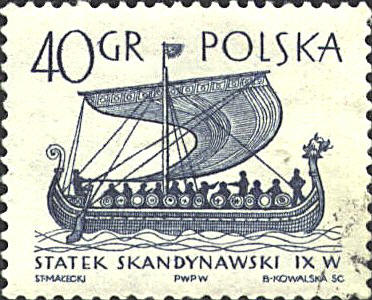|
In 1880 a Viking
Langskipet (Longship) was discovered in a barrow at Gokstad farm,
on the Sandefjord near Oslo, Norway. The ship was built in the ninth
century of oak. It was approximately 76 feet long, 17 feet wide, and 7
feet high from the bottom of the keel to the gunwale. It was clinker-buillt with 16 pairs of oars. It could have shipped 16 tons. The mast
was perhaps 40 feet high, with a single sail known as a beiti-ass,
made of wool. It had been used for a burial chamber, perhaps for a
king, and contained 12 horses, 6 dogs and a peacock. The remains
of the ship were moved from Lahelle (Vestfold, Sandefjord) to Oslo.
The Gokstad ship is the first Viking ship to be excavated.
The stamp shows an artist's impression of the Gokstad
ship in the style of the Bayeux Tapestry, with a dragon's head on the
prow.

The Columbian Exposition
was held in 1892 in Chicago to celebrate the discovery of the western
hemisphere by Christopher Colombus in 1492. The Exposition wanted, and
the Norwegian state agreed, a replica of this ship for display at the
Exposition. A replica of the Gokstad ship was built at Christen
Christensen’s Framnes Shipyard in Sandefjord as close to the original
as possible. The ship was 24 meters long, 5 meters wide, with a mast
15 meters high, and equipped with a 9 by 12.5 meter sail. It had holes
for 16 pairs of oars; it cost 12,000 kroner.
The name “Leif Ericson” was rejected as too
controversial for the Columbian Exposition, so the name was changed to
“Viking.” It sailed from Bergen on April 30, 1893, and arrived on June
13, 1893 at New London, Connecticut (44 days). It was displayed at the
Columbian Exposition, and then donated to the city of Chicago, where
it exhibited to the public until 1993.

In 1925 to publicize and promote the Norse American
Centennial in St. Paul a set of two stamps was issued, one of them
bearing a picture based on the Gokstad replica, “Viking.” taken from a
photograph. The engravers even included the American flag waving from
the bow, as it was on the replica.

 |
